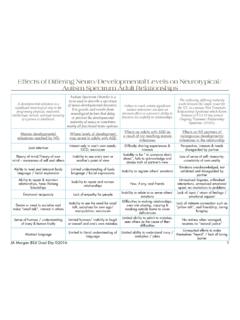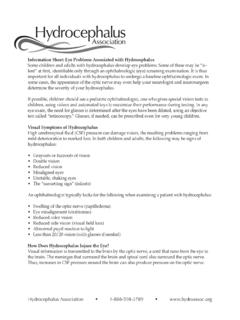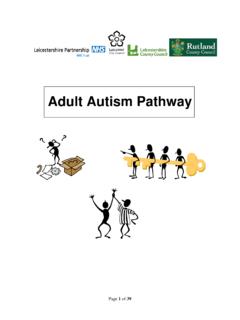Transcription of Management of apnoea and bradycardia in …
1 Management of apnoea andbradycardia in neonatesEve AtkinsonAlan C FentonAbstractApnoea is common in the preterm infant, particularly those less than 30weeks gestation. It results from a combination of central and obstructivefactors in the otherwise well preterm infant but can also be a sign ofunderlying pathology: therefore the diagnosis of apnoea of prematurityis one of exclusion. apnoea and associated bradycardia and hypoxaemiamay require cardiovascular resuscitation and may be associated with longterm adverse neurodevelopmental sequelae. A variety of physical andpharmacological treatments have been used with the aim of reducingthe severity of episodes and ultimately improving long term is currently the drug of choice in the treatment of apnoea ,supplemented in refractory cases by additional mechanical respiratorysupport. Long term follow up of affected infants within multi-centre trialsis key to optimising Management ; bradycardia ; Management ; neonate; pretermIntroductionNeonatal apnoea is a common problem particularly in thepreterm population.
2 The American Academy of Pediatrics definesapnoea as a pause in breathing for more than 20 seconds orshorter pauses that are also associated with desaturation, bradycardia , pallor or reduced tone. Severe episodes, associatedwith hypoxaemia and reduced cardiac output, may requireresuscitation and have the potential to cause brain diagnosis and Management is important to ensuresecondary causes are appropriately treated and the consequencesof severe apnoea are minimised. Several treatment options, bothpharmacological and non-pharmacological, are available to treator potentially prevent apnoea . The aim of this review is toevaluate the evidence base for the use of these therapies in theneonatal and diagnosisApnoea can be classified physiologically as central, obstructiveor mixed. Central apnoea occurs when there is absence ofrespiratory drive. In obstructive apnoea the infant makescontinued respiratory effort but airflow is restricted due to airwaycollapse.
3 If the obstruction persists CNS depression due tohypoxia and acidosis will result in mixed apnoea . For themajority of preterm infants a mixed picture is seen with bothobstructive and central factors contributing with only 10% ofpreterm apnoea being due solely to airway of prematurity (AOP) is a diagnosis of exclusion andtherefore thorough examination and appropriate investigation isessential to diagnose and treat secondary causes (Table 1). Theclinical picture will determine the extent of investigation but mayinclude a septic screen, full blood count, chest X-ray, blood gas,serum electrolytes and glucose, EEG, pH testing and neurologicalimaging. Many of the conditions listed inTable 1are associatedwith apnoea but this does not necessarily imply causation andcare must be taken when attributing the cause of apnoea . Forexample gastro-oesophageal reflux is much more common inpreterm infants and is often falsely attributed as a cause ofapnoea but this may not always be the incidence of apnoea is significantly greater in preterminfants affecting just under 10% of infants born at 34e35 weeks,increasing to 50% of those born between 30e31 weeks with aneven higher incidence in extremely preterm infants.
4 Although theprecise underlying mechanisms responsible for AOP have notbeen fully defined, physical differences and immature physiologyare important contributors. A large occiput, hypotonic neckmuscles and smaller airways increase the risk of upper airwayobstruction and with reduced reserves the preterm infant is morelikely to tire. Immaturity of the pathways involved in respiratorydrive and exaggerated inhibitory responses are thought to be themain physiological pathways involved. Several neurotransmit-ters including GABA, adenosine, serotonin and endorphins areunder scrutiny as are cytokines involved in prostaglandin is hoped that by defining the exact pathways and chemicalsinvolved in AOP, development of more specific therapies maybecome possible, thus reducing potential side effects of non-specific blockade of receptors such as the adenosine receptorstargeted by & monitoringChanges in heart rate, respiratory rate, oxygen saturation andrespiratory effort aid in the identification and Management ofapnoea.
5 Quantifying the severity of episodes can be difficult butdata monitoring and recording may help in assessment of apnoeaseverity in addition to clinical observation, thus aiding diagnosisand helping to monitor treatment outcomes. The limitations ofmonitoring devices must be taken into account. For example anapnoea mattress will not alarm in obstructive apnoea if the infantcontinues to make respiratory effort and it is acknowledged thatthe use of home apnoea monitors has not reduced the incidenceof SIDS. Other monitoring devices including impedence pneu-mograpy, respiratory inductance plethysmography, end tidal CO2monitoring and thermistor beads provide additional measuresbut are usually confined to the research episodes leading to prolonged hypoxia and bradycardiamay require cardiovascular resuscitation. Identification andappropriate treatment of contributing factors is essential in allEve AtkinsonMBBS MRCPCHis a Specialist Registrar at NewcastleNeonatal Service, Royal Victoria Infirmary, Queen Victoria Road,Newcastle upon Tyne, NE1 4LP, C FentonMD MRCPis a Consultant Neonatologist at NewcastleNeonatal Service, Royal Victoria Infirmary, Queen Victoria Road,Newcastle upon Tyne, NE1 4LP, : NEONATOLOGYPAEDIATRICS AND CHILD HEALTH 19:12550 2009 Elsevier Ltd.
6 All rights HKMA CME MEMBER USE ONLY. DO NOT REPRODUCE OR DISTRIBUTEFOR HKMA CME MEMBER USE ONLY. DO NOT REPRODUCE OR DISTRIBUTE cases of neonatal apnoea . Additional respiratory support, phys-ical and pharmacological treatments may also be required. Theaim of therapy is to reduce the severity of hypoxaemia andultimately prevent adverse neurological outcome. It is thereforeimportant to ensure that short term gains are free from long termadverse effects. Ideally long term follow up of adequately pow-ered RCTs of available treatments would help to determine theeffectiveness of the many therapies available. Teasing out theeffects of apnoea from other prematurity associated factors isalso challenging. The mainstays of therapies available are bothpharmacological and non-pharmacological each with varyingamounts of evidence to support their treatmentsMethylxanthinesMethylxanthines have been used as a treat-ment for neonatal apnoea since the early 1970s.
7 Their effective-ness in increasing minute ventilation, CO2sensitivity anddiagphragmatic breathing, whilst reducing periodic breathingand hypoxic episodes is well documented. Caffeine is now one ofthe most commonly used drugs in neonatal care. The effective-ness of caffeine was demonstrated by a small number of studiesand as a result few RCTs have taken place. A Cochrane reviewincluding 5 small studies (192 infants) demonstrated a significantdecrease in apnoea and the need for IPPV in the first 2e7 days oflife in those infants receiving caffeine compared to placebo or notreatment, with a second review demonstrating equal efficacywhen compared to theophylline. The much wider therapeuticindex, once daily dosing, reduced side effect profile, increasedCSF penetration and equal efficacy has favoured the use ofcaffeine over theophylline or mechanism of action of methylxanthines as a respiratorystimulant is still to be elucidated but it is generally accepted thatnon-specific inhibition of A1 and A2a adenosine receptors isa key effect.
8 These receptors are found throughout the bodytherefore concerns that non-specific blockade may haveunwanted side effects has been raised. Short term side effects ofcaffeine include a 20% increase in metabolic demand, diuresis,tachycardia, dysrythmias, feed intolerance, reduced weight gainand rarely seizures. In the long term worries over potentialadverse neurodevelopmental outcomes and other neonatalmorbidities such as necrotising enterocolitis, retinopathy ofprematurity, bronchopulmonary dysplasia, reduced growth andbehavioural problems led to the Caffeine for apnoea of Prema-turity (CAP) trial. Over 2000 infants weighing 500e1250 g atbirth were randomised to caffeine or placebo. In addition to shortterm benefits of reduced apnoea and a reduction in ventilatorysupport, follow up at 18e21 months has also shown a reductionin death or survival with neurodisability and a reduced incidenceof cerebral palsy and cognitive delay in those who receivedcaffeine.
9 Further follow up is planned at 5 years. In the interimthese results are very encouraging and provide some reassurancethat improved short term outcomes are not at the expense of longterm adverse is a potent respiratory stimulant that hasbeen shown to increase minute volume by increasing respiratoryrate in adults. The response is dose related with effects at lowerlevels mediated by the carotid bodies and those at higher levelsmediated by the brainstem. Use in neonatal apnoea has beendocumented, particularly when treatment with caffeine are however only a small number of studies inneonates. A Cochrane review found only one small trial of 21infants carried out in 1990. Although fewer treatment failureswere seen after 48 hours in those who received doxapram theresult was not significant and the cross-over design of the studyalso prevented evaluation after 48 hours in the placebo group. Nolong term outcomes were measured and the authors concludethat there is insufficient data to evaluate the precision of theresults or potential adverse effects; they suggest further studiesare required to determine the role of doxapram in other studies have highlighted side effects includinghypertension, seizures and GI disturbance with one study alsoreporting second-degree heart block in 3 infants that resolvedfollowing discontinuation of doxapram.
10 A decrease in maximalcerebral blood flow velocity has also been demonstrated and theoral preparation is poorly absorbed and tolerated. A smallnumber of studies have also reported adverse neuro-developmental outcomes. One group of 40 infants treated withdoxapram were found to have a lower mental developmentalindex at 18 months than controls. Confounding effects of possibleunderlying cerebral dysfunction cannot be ruled out and therewas no comparison with frequency, duration and severity ofapnoea. Studies in rats under ischaemic conditions have shownincreased white matter damage with the use of associations/causes of apnoeaInfection (bacterial and viral)Sepsis, meningitis, NECN eurologicalIntracranial haemorrhageSeizuresAsphyxiaCongenital malformationsRespiratory/CardiovascularH ypoxaemia, RDS, pneumoniaaspirationPDAH ypovolaemia, hypotensionHeart failureHaematologicalAnaemiaGastrointest inalGORDA bdominal distensionDrugs (infant and maternal)OpiatesMagnesiumProstaglandinsC onsider drug withdrawalAcute/chronic painAirway malformationHead/body positionMetabolicHypoglycaemiaHypocalcae miaHypothyroidismHyponatraemiaTable 1 SYMPOSIUM: NEONATOLOGYPAEDIATRICS AND CHILD HEALTH 19:12551 2009 Elsevier Ltd.






